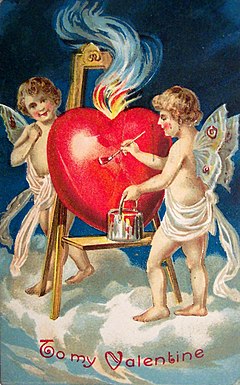It's time to think about that sweetest time of the year--Valentine's Day! Did you know that Valentine's Day is celebrated in various countries around the world? It is a time to show your love and affection for someone special in your life.
I'm thinking about Valentine's Day because the brown headed kid asked for a table runner for her new home--she requested this valentine one.
Joy Shope has the tutorial--we are stash diving for this one!
Should be fun to create for her table.
Other patterns are found here on this site--have fun!
and for some history, we have this from Wikepedia........
Valentine's Day, also known as
Saint Valentine's Day or the
Feast of Saint Valentine,
[1] is a celebration observed on February 14 each year. It is celebrated in many countries around the world, although it is not a public holiday in most of them.
St. Valentine's Day began as a liturgical celebration of one or more early
Christian saints named
Valentinus. Several martyrdom stories were invented for the various Valentines that belonged to February 14, and added to later
martyrologies.
[2] A popular
hagiographical account of Saint Valentine of Rome states that he was imprisoned for performing
weddings for soldiers who were forbidden to marry and for ministering to Christians, who were
persecuted under the Roman Empire. According to
legend, during his imprisonment, he healed the daughter of his jailer, Asterius. An embellishment to this story states that before his execution he wrote her a letter signed "Your Valentine" as a farewell.
[3]Saint Valentine's Day is an official
feast day in the
Anglican Communion,
[4] as well as in the
Lutheran Church.
[5] The
Eastern Orthodox Church also celebrates Saint Valentine's Day, albeit on
July 6 and
July 30, the former date in honor of the Roman
presbyter Saint Valentine, and the latter date in honor of
Hieromartyr Valentine, the Bishop of Interamna (modern
Terni).
The day was first associated with
romantic love in the circle of
Geoffrey Chaucer in the
High Middle Ages, when the tradition of
courtly love flourished. In 18th-century England, it evolved into an occasion in which
lovers expressed their love for each other by presenting flowers, offering
confectionery, and sending
greeting cards (known as "
valentines"). In Europe,
Saint Valentine's Keys are given to lovers "as a romantic symbol and an invitation to unlock the giver’s heart", as well as to children, in order to ward off
epilepsy (called Saint Valentine's Malady).
[6] Valentine's Day symbols that are used today include the
heart-shaped outline, doves, and the figure of the winged
Cupid. Since the 19th century, handwritten valentines have given way to mass-produced
greeting cards.
[7]
Crayola has coloring pages!! for you to download and color!
And if you need something to write in those Colorful cards, you can find
Poems! Much sweeter than candy!





















